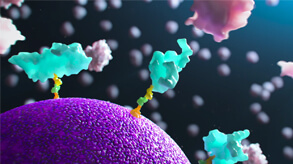COVID-19:
6. Facilitate vaccine development
Find COVID-19 protein expression patterns to accelerate COVID-19 vaccine development
- Find/monitor proteins that reflect clinical response to vaccines
- Identify immune proteins that reflect long-term clinical effect
- Accelerate vaccine development and evaluation
Infectious disease researchers are increasingly turning to the SomaScan® assay to monitor immune response
Monitoring changes in protein levels following Swine Flu and Bird Flu infection
Influenza A viruses are a constant threat to public health, causing both seasonal epidemics and global pandemics. Designing safe and effective drugs is difficult because type A flu viruses can mutate quickly and because they can infect animals (such as pigs, birds, bats and horses), evolve and then reemerge in humans. Viruses use the host’s cells to replicate and spread, so identifying host factors that are affected by infection is important for developing anti-viral strategies. In this article, scientists at the University of Manitoba and the Public Health Agency of Canada examined the effects of influenza type A infection on the levels of 1310 host proteins using the SomaScan assay. They infected human lung cells with five different influenza type A viruses: three H1N1 strains (including the 2009 pandemic strain) and two avian strain (the H5N1 “Bird flu” and an H7N9 strain with low pathogenicity in birds, but high pathogenicity in humans). Compared to mock-infected cells, the levels of more than 500 proteins were changed significantly by one or more of the viruses, although no protein was changed significantly by all five. The two avian strains showed the largest effects, decreasing the levels of many proteins involved in important cell functions. These results warrant further investigation as they may help explain why the avian flu strains have such high pathogenicity in humans.
Measuring proteins important for fighting lung infections
The body produces antimicrobial peptides and proteins (APPs) that can directly kill foreign pathogens and modulate the immune response. To better understand how APPs work in fighting lung infections, researchers at the University of Manitoba used the SomaScan assay to measure the levels of 39 APPs produced by bronchial cells before and after being stimulated by either interleukin-17 (IL-17), tumor necrosis factor (TNF), or interferon-gamma (IFN-g); three proteins that enhance airway inflammation. TNF and IL-17 caused similar responses, but IFN-g was quite distinct. These results suggest that the presence of different inflammatory proteins can affect APP production and infection control.
Assessing the effects of an antiretroviral therapy in HIV
HIV-infected individuals take antiretroviral therapies to help keep the virus at bay, but still suffer from systemic inflammation and immune dysfunction, which affects their quality of life and ability to survive. In this article, researchers at the Children’s Hospital of Philadelphia Research Institute and the Perelman School of Medicine at the University of Pennsylvania describe a dose and time escalation clinical trial of the anti-inflammatory drug aprepitant on 12 HIV-positive patients. The goal was to see if co-administration of aprepitant with ritonavir (an antiretroviral medication) would safely reduce residual inflammation. The SomaScan assay was used to assess the global effects of aprepitant and identified 176 plasma proteins whose levels changed after drug treatment. These included proteins involved in inflammation and immune regulation as well as blood, lipid and cholesterol metabolism, which warrant caution and further investigation.
Additional use cases

Predict progression
Predict which COVID-19 patients will progress and develop severe illness

Identify disease subtypes
Identify COVID-19 disease complication sub-types in those at risk for severe illness

Repurpose existing drugs
Repurpose existing drugs by matching them with drivers of COVID-19 progression

Identify new drug candidates
Rapidly identify protein targets for new drug candidates for COVID-19





